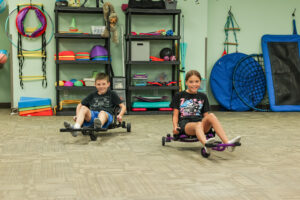
Understanding Occupational Therapy for Elementary and Middle School Students
Occupational therapy (OT) is an essential service that helps students develop the skills they need to participate fully in their education and daily life activities. For elementary and middle school students, OT focuses on improving a wide range of skills that may affect their learning, social interactions, and overall well-being. But what exactly does OT involve for students in these age groups? Let’s explore how OT can make a significant difference in their development and success.
What is Occupational Therapy?
In the context of elementary and middle school, OT typically focuses on helping children develop the physical, sensory, cognitive, and emotional skills needed to be successful in school and home settings. OT practitioners use a variety of strategies and activities to support these children..
How Does Occupational Therapy Help Students?
- Fine Motor Skills Development Many students, particularly in elementary school, struggle with fine motor skills — the small, coordinated movements of the hands and fingers. These skills are crucial for tasks such as writing, drawing, cutting with scissors, and using a computer keyboard. OT helps children strengthen these skills through fun and engaging activities that build hand strength and coordination.
- Sensory Processing Some children may have difficulty processing sensory information. For instance, they might be overly sensitive to noise, light, or touch, while others may seek out intense sensory experiences. Occupational therapy helps these children regulate sensory input so they can focus and participate in classroom activities without becoming overwhelmed or distracted.
- Handwriting and Writing Skills Handwriting remains an important academic skill in elementary and middle school. However, some students struggle with writing due to issues like poor hand strength, poor pencil grip, or challenges with letter formation and organization. OT provides strategies to improve handwriting and writing endurance, making sure children are not only able to write legibly but also comfortably and efficiently.
- Self-Regulation and Emotional Control Middle school students, in particular, experience a wide range of emotions, and some may struggle with managing their feelings in a classroom environment. Occupational therapists help children with strategies to manage emotions, reduce stress, and increase self-awareness. This can involve activities like mindfulness, breathing exercises, or the use of calming tools to help students stay focused and engaged.
- Social Skills and Peer Interactions Social development is key for both elementary and middle school students. Occupational therapy provides strategies to help students develop better communication and social interaction skills. Children with autism, ADHD, or other developmental disorders may benefit from OT interventions aimed at improving their ability to understand social cues, take turns, and resolve conflicts.
- Executive Functioning Skills Executive functions are cognitive processes that help students plan, organize, and complete tasks. These skills are crucial for academic success but can be challenging for students with ADHD, learning disabilities, or other conditions. Occupational therapists can help students with time management, task initiation, organization of schoolwork, and memory strategies.
- Play and Leisure Skills Play is a critical part of a child’s development. Occupational therapy helps children engage in structured play activities that promote problem-solving, creativity, and social skills. For children with disabilities or developmental delays, OT ensures they have the opportunity to engage in these meaningful activities, which are vital for their growth and development.
How Occupational Therapy Looks For This Age Group
Therapists assess each student’s needs through observations, standardized tests, and collaboration with the child’s parents. Based on the assessment, OT interventions are tailored to the child’s specific needs and abilities, which might include physical exercises, strategies for sensory regulation, environmental modifications, or learning new ways to approach tasks.
Benefits of Occupational Therapy for Elementary and Middle School Students
- Improved Academic Performance: By addressing fine motor, sensory, and cognitive challenges, OT helps students perform better in academic tasks such as writing, focusing, and following directions.
- Increased Independence: Students gain the skills they need to be more independent in daily activities like self-care, getting organized, and managing their emotions.
- Enhanced Social Interactions: OT helps children with social difficulties develop the skills needed for positive peer interactions and better communication.
- Better Self-Esteem: As students become more confident in their abilities, they experience improved self-esteem and a greater sense of accomplishment.
- Stronger School Participation: Occupational therapy helps ensure that all students, regardless of challenges, can engage in and benefit from school activities.
All In All ….
Occupational therapy for the elementary and middle school populations provides students with the tools and strategies they need to overcome challenges, reach their full potential, and thrive both academically and socially. Whether helping a child improve their handwriting, manage sensory sensitivities, or develop better emotional control, OT plays a key role in helping students become successful, confident, and capable individuals in the classroom and beyond.
If you think your child might benefit from occupational therapy, call our office at 406-647-0042 or text “get started” at 406-384-6311. The sooner support is provided, the greater the positive impact it can have on their development and future success.





No comment yet, add your voice below!